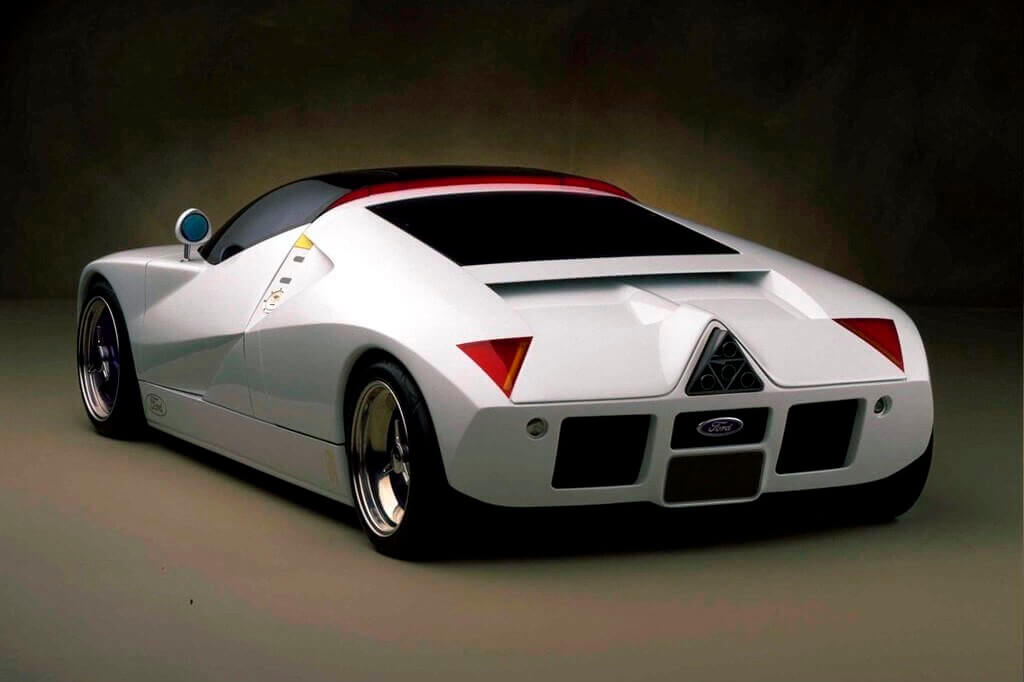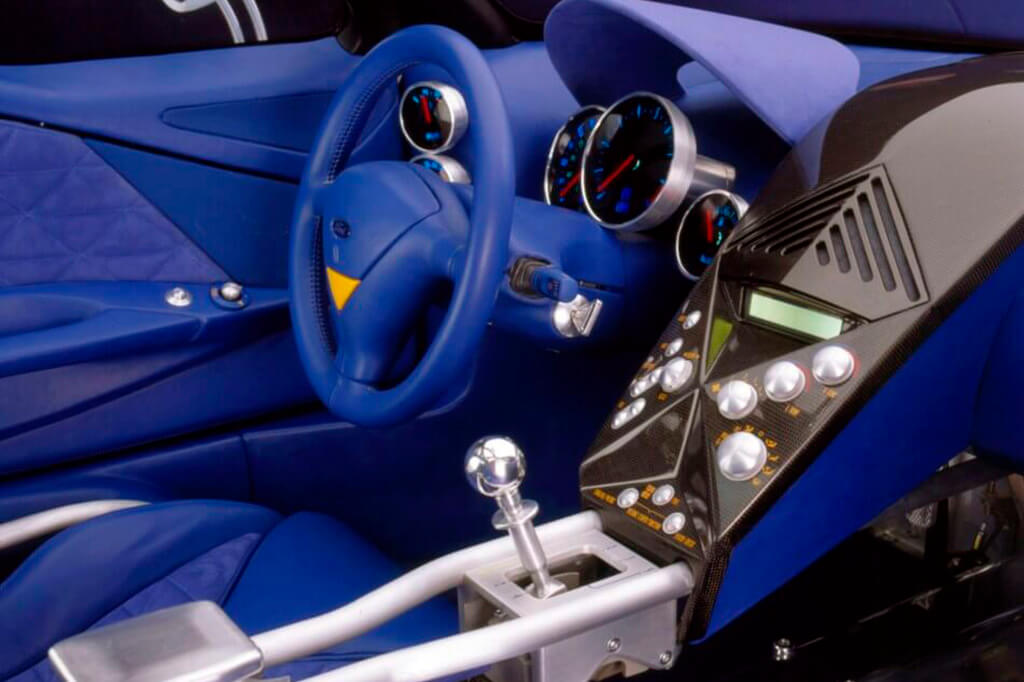Ford GT90 Concept
Description
The Ford GT90 Concept is a prototype two-seat supercar designed as a modern interpretation of the famous 1960s Ford GT40 racing car. The GT90 received roof-spanning doors, but otherwise it had little in common with its predecessor. The GT90 was finished in bright white with a bright blue carbon fiber interior inspired by Ford's "New Edge" design.
Development
The car was presented in 1995 at the Detroit Motor Show (North American International Auto Show, NAIAS) as "the most powerful supercar in the world." The purpose of the creation was to ensure that the car took its rightful place among the supercars of the time, such as the Ferrari F50, Lamborghini Diablo, Bugatti EB 110 and McLaren F1. He even surpassed the latter in terms of performance: maximum speed - 378 km / h, acceleration to 60 mph – 3.1 s, power – 720 hp. However, this did not bring him fame, because. the data were theoretical and no official measurements were made.
After the introduction in Detroit, the GT90 went to other auto shows in 1995, in Frankfurt and even in Tokyo. The prototype is currently on display at the Hajek Motorsports Museum, Ames, Oklahoma.
The GT90 was built as a secret project by a small team of engineers at Ford SVT in just six months. As development times were tight, many components were borrowed from other cars, including the powertrain and chassis from the Jaguar XJ220 (also well ahead of its time), since Jaguar was owned by Ford at the time.
The project cost Ford $3 million. and was a test bed for testing advanced technologies and design. The car was not intended for mass production, because Ford considered this project too ambitious, and production costs would be prohibitive, and according to company executives, customers would continue to prefer Italian cars over Ford, even if it was better, because with its the name is associated with lower-level products.
Facts
The GT90 could be ridden in video games. In the racing game Need for Speed 2 from the American manufacturer Electronic Arts, it was possible to drive a GT90 on the tracks included in the game. The prototype was also included in the PlayStation game Gran Turismo 2. Also in Sega GT 2002 (Xbox), Ford Racing 2, 3 and Street Racing for PlayStation 2, TOCA Race Driver 2 (PS2), Ford Vs. Chevy (PS2), Project Gotham Racing 3 (Xbox 360), and Rush 2: Extreme Racing USA for the Nintendo 64. The unlicensed GT90 was playable in the Jeff Gordon XS Racing racing game.
The car was also tested by Jeremy Clarkson on the 1995 Top Gear TV show.
Engine
The GT90 was equipped with a V12 engine with an aluminum block and cylinder heads, which had a volume of 5.9 liters and developed an output of about 720 hp. and 895 Nm of torque. It was fitted with four Garrett T2 turbochargers. The engine architecture was based on Ford's 90-degree modular engine family, with the same architecture, bore and stroke as the 4.6-liter Lincoln V8, but with the addition of four more cylinders, two in each bank. cylinders. The result is a 90-degree V12 with a bore of 90.2mm and a stroke of 77.3 mm. The exhaust gases were heated to such a temperature that the exhaust pipes had to be protected from the body panels with special heat-resistant ceramic protection, similar to that used in the American Space Shuttle spacecraft.
Transmission
The power produced by the engine was sent to the rear wheels via a 5-speed manual transmission jointly developed by FF Developments and Ricardo, which was also used on the Jaguar XJ220.
Dynamics
According to Ford's official figures, the prototype could accelerate from 0-60 mph in just 3.1 seconds and reach a theoretical top speed of 378 kph, according to some sources, and up to 407 kph, according to others.
Chassis
The GT90 was built around an aluminum monocoque and its body panels were made from carbon fiber (or aluminium-reinforced fiberglass).
The double wishbone suspension was also borrowed from the Jaguar XJ220, as was the gearbox. The rack and pinion steering was equipped with an amplifier. The tires were specially made for the prototype with "GT90" written right into the tread.
Exterior
The prototype's aerodynamic body formed the basis of the "New Edge" styling concept adopted by Ford at the time, characterized by sharp corners and flat surfaces, which was later adopted by other Ford models such as the Ka, Cougar and Focus.
One of the most impressive features of the GT90 was the massive dome-style front tinted laminated glass that extended heavily into the roof. Hinged doors spanned part of the roof, hinting at the resemblance to a 1960s Ford GT40. In the tail section there was a wing that rose for additional stability at high speeds.
Interior
The interior of the prototype was accessed by pressing a small yellow panel located on the B-pillar that allowed the door to swing open. Surprisingly for such a supercar, the cabin was relatively easy to climb in, as the threshold was low and narrow, and the glass, which protruded strongly into the roof, was part of the door. Reminiscent of an airplane cockpit, the interior was trimmed in bright blue suede and leather, the carbon fiber center console and gauges were blue-lit. An abundance of brushed and polished aluminum adorned the interior, from the control levers on the center console to the car key. It was also possible to control the doors and headlights from the remote control.
Sources
Specification
| Bodywork | |
|---|---|
| Presentation | |
| Years of production |
1995
|
| Produced (pcs.) |
1
|
| Body type |
купе
|
| Number of doors |
2
|
| Number of places |
2
|
| Engine | |
|---|---|
| Engine type |
бензиновый
|
| Engine location |
центральное, продольное
|
| Engine model |
Ford
|
| Cylinders |
V12
|
| V-angle |
90°
|
| Capacity (cc) |
5927
|
| Power output (hp / kW /) |
720 /
529 /
|
| at rpm |
6600
|
| Torque (N·m) |
895
|
| at rpm |
4750
|
| Bore (mm) |
90,2
|
| Stroke (mm) |
77,3
|
| Compression |
8,0
|
| Number of valves |
4/48
|
| Valvetrain |
DOHC
|
| Block material |
алюминиевый сплав
|
| Fuel system |
впрыск
|
| Turbocharger |
4
|
| Compressor model |
Garrett Systems T2
|
| Specific | |
|---|---|
| Specific output (hp/litre) |
121,48
|
| Specific output (hp/tonne) |
496,21
|
| Specific output (kg/hp) |
2,02
|
| Specific torque (N·m/litre) |
151,00
|
| Specific torque (N·m/tonne) |
616,82
|
| Transmission | |
|---|---|
| Driven wheels |
задний
|
| Gearbox model |
FFD-Ricardo
|
| Gearbox |
механическая
|
| Number of speeds |
5
|
| Suspension | |
|---|---|
| Front suspension |
независимая на двойных поперечных рычагах
|
| Rear suspension |
независимая на двойных поперечных рычагах
|
| Elastic elements in front |
пружины
|
| Elastic elements in rear |
пружины
|
| Front anti-roll bar | |
| Rear anti-roll bar | |
| Wheel size front |
10,0J×18
|
| Wheel size rear |
13,0J×19
|
| Tire brand |
Goodyear
|
| Tyres front |
275/35 R18
|
| Tyres rear |
355/30 R19
|
| Steering | |
|---|---|
| Steering type |
шестерня-рейка
|
| Power steering |
да
|
| Brakes specs | |
|---|---|
| Brakes front |
дисковые вентилируемые
|
| Brakes rear |
дисковые вентилируемые
|
| Front brake diameter (mm) |
328
|
| Rear brake diameter (mm) |
328
|
| Anti-lock braking system |
да
|
| Dimensions and weight | |
|---|---|
| Body |
монокок с панелями
|
| Body material |
углеволокно
|
| Length (mm) |
4470
|
| Width (mm) |
1963
|
| Height (mm) |
1140
|
| Wheelbase (mm) |
2946
|
| Front track (mm) |
1722
|
| Rear track (mm) |
1613
|
| Drag coefficien |
0,320
|
| Curb weight (kg) |
1451
|
| Performance specs | |
|---|---|
| Fuel tank capacity (l) |
68
|
| Fuel type |
Аи-95
|
| Dynamic specs | |
|---|---|
| Acceleration 0-100 kph (s) |
3,2
|
| Acceleration 0-60 mph (s) |
3,1
|
|---|---|
| Acceleration 0-100 mph (s) |
6,2
|
| Acceleration 0-402 m (1/4 mile) (s) /kph/ |
10,9 /
225,0 /
|
|---|
| Top speed (kph) |
378
|
|---|---|
| Top speed (mph) |
235
|



